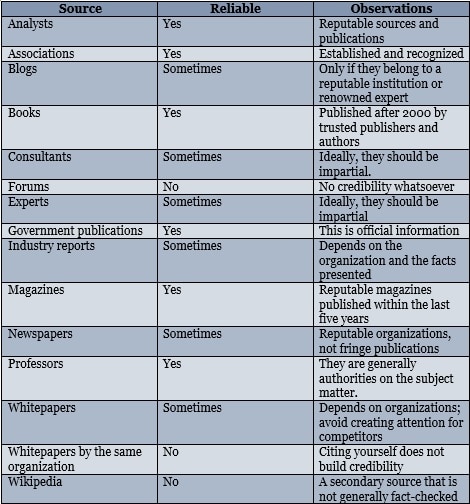Tag: Whitepapers
The Four Most Common Mistakes in Whitepapers
Producing successful whitepapers takes a combination of skill and creativity. It requires a practical approach that can help writers get their message out there and, in turn, provide readers with the information they seek.
However, there are cases in which a whitepaper fails to deliver. When a paper fails, writers may be left wondering what went wrong.
In this article, we focus on the four most common mistakes in whitepapers and how to solve them. By paying attention to this article’s guidelines, producing a successful whitepaper will become far more straightforward.
Mistake #1: A Weak Argument

A useful whitepaper is similar to an ironclad court case. And just as trial lawyers need to create airtight cases so they can prove their argument beyond a reasonable doubt, a whitepaper not only needs to build a logical and consistent argument but also back it up accordingly.
Graham Gordon, whitepaper writer extraordinaire, has this insight to offer on building a successful argument:
“Every white paper writer must learn how to build a coherent argument. Without one, your white papers won’t convince anyone of anything. But a white paper that presents a strong argument can be right on the money. It can generate great results for years running.”
Indeed, the best arguments stand the test of time. Yet, writers are often guilty of committing several mistakes.
The most prominent sin that writers commit when building an argument is to use overly complicated ideas. Some writers misguidedly believe that the more complex an argument is, the more it will succeed.
However, complex arguments tend to have too many moving parts. Thus, each component is an opportunity for competitors to attack its logic and consistency.
On the other hand, a simple argument is much harder to refute. Debunking a simple, well-constructed idea generally requires a mountain of data. While competitors may try, they will eventually give up.
Another hazardous characteristic of a weak argument is assuming that readers already know or understand the argument’s points.
Good trial lawyers walk jurors through every facet of their argument, even if the risk is going over minutiae. In doing so, they avoid leaving gaps in their arguments. After all, even a small gap can become a huge chasm.
For instance, assuming that all shoppers prioritize quality over cost is a dangerous proposition. After all, there might be shoppers that do not care about quality and instead want the cheapest product available regardless of quality.
To combat weak arguments, whitepaper writers must challenge their arguments as rigorously as possible.
Trial lawyers simulate courtroom conditions to test the strength of their arguments. This exercise often reveals cracks in arguments, and most importantly, how to address them. In the same sense, whitepaper writers must become their own critics to ensure they have covered every possible angle.
A telltale sign of a weak argument is the use of generalizations. Blanket statements do very little to push the persuasive nature of an argument. Moreover, generalizations do not provide the reader with any actionable insight.
For example, a statement such as “consumers prefer high-quality products” does not offer any useful information. In contrast, “90% of consumers surveyed indicated they prefer high-quality over low price,” provides an insightful tidbit of information readers can internalize. Consequently, whitepaper writers must always strive to be as specific as possible.
When writing a whitepaper, bear in mind that the devil is in the details. Detailed arguments go a long way toward plugging up gaps in the argument’s overall construction.
Mistake #2: Insufficient Evidence

Whitepapers must base their arguments on concrete evidence. Without the use of enough evidence to support claims, a whitepaper may drift into the realm of opinion.
While there is nothing inherently wrong with publishing an opinion, it is not a whitepaper. A whitepaper serves as a persuasive argument that compels readers to act, or in the most ambitious of cases, change their minds on a specific issue.
The best kind of evidence comes from reliable sources. These sources are individuals acknowledged as experts in their field and official institutions such as government, academia, or industry leaders.
These sources enable readers to trust the information provided in the paper. Citing data from fringe websites, obscure writers, or unknown publications may lead readers to doubt the accuracy of the paper’s data.
Above all, whitepaper writers should strive to present as much quantitative data as possible. Quantitative data encompasses information stemming from surveys, laboratory research, official government statistics, and verified public data. Ultimately, cold, hard numbers go an incredibly long way to support a compelling argument.
Additionally, there is plenty of room for qualitative data. For example, expert opinions on a subject can boost the credibility of a paper’s argument. When multiple experts echo the view presented in a paper, the argument can truly begin to take shape.
Trial lawyers use this same kind of motivation when calling expert witnesses to the stand. Expert witnesses have technical expertise that lawyers do not. Consequently, these witnesses serve to show jurors the argument’s veracity.
Unfortunately, some whitepaper writers commit a fatal error by not presenting sufficient evidence. A good rule of thumb to keep in mind is the more proof, the better.
While there is no specific number of sources that a paper should use, writers should strive to find as many pieces of evidence as possible. Evidence serves to build credibility. Without it, a paper is far easier for critics to dismiss. Conversely, concrete evidence gives any whitepaper the backing it needs to be successful.
Graham Gordon, the Whitepaper Guy, says that the use of sources in whitepapers “elevates the level of discourse in your white paper, and in your industry, to rely more on evidence and less on hype.”
Basing the claims in a paper on evidence provides a solution based on a solid foundation of fact and not merely hot air. Hype can easily get debunked when someone takes the time to do their due diligence. If a competitor wants to get an edge on their competition, they will undoubtedly take the time to check up on the hype.
Graham warns of making up “facts,” though. This statement does not necessarily pertain to falsifying information. It refers to making loose affirmations that appear to be true. However, they do not hold up to scrutiny.
For instance, claiming a specific aggregate market value of a product based on an estimation would be irresponsible to include in a legitimate paper. While it is entirely possible to utilize estimated data, estimates should always use a sound methodology. Making claims on unverified assumptions can quickly bash a paper’s credibility.
Mistake #3: Obscure Sources

There is no question that solid research is the backbone of every compelling whitepaper. However, a paper’s research is only as good as its sources.
Often, writers try to cut corners by citing obscure sources or unknown individuals. In the worst of cases, some whitepapers make significant claims based on a single piece of evidence. A paper could avoid initial vetting/review if it is self-published—say on a website, but that may not shield it from eventual exposure of its flaws.
When it comes to sources, mainstream ones provide the best support. After all, journalistic articles from CNN or The New York Times carry much more weight than ones from thetruthrevealed.com. While it may seem silly to consider that a professional whitepaper writer would use such sources, it should not come as a surprise that inexperienced writers may try to pull a fast one.
At the core of reliable sources of information is trust. There is a proven psychological link between a source and an individual’s ability to trust the data.
Take children, for example. It has been proven that children associate the integrity of information based on its source. This implicit association implies that children are far likelier to trust anything a parent or guardian would say as opposed to a stranger.
The concept of trusting information based on the source remains with most people into adulthood, leading them to take information from trusted sources at face value naturally.
Influential whitepaper writers are keenly aware of the importance of trust. And trust is everything when it comes to writing a persuasive paper. Even when claims sound unbelievable, trustworthy sources, coupled with a consistent argument, are the winning formula to a successful whitepaper.
A clear example of an unreliable source is Wikipedia. Wikipedia is an open-source repository of knowledge and information. Since it is open-source, practically anyone can contribute to a specific topic. However, Wikipedia does not have a rigorous verification methodology like academic journals do. Consequently, there is no guarantee that the information contained in it is genuinely accurate. Thus, readers are left to determine the degree of Wikipedia’s credibility for themselves.
Wikipedia serves as a cautionary tale on the use of obscure sources. Any professional writer will agree that using Wikipedia as an official source will quickly get a paper discredited. Finding credible sources may represent extra work. However, the payoff is certainly worth the additional effort.
Mistake #4: Confirmation Bias

Often, finding the right piece of information to lock down an argument can be complicated. Depending on the nature of the argument, sources may be more or less abundant. And, in some cases, information may not even exist.
In such cases, whitepaper writers may have to produce the information themselves through surveys, statistical modeling, or experimentation.
Ideally, writers should conduct research in such a way that the data makes the argument come to life. Whatever it may be, the data ought to provide the support needed to reinforce the paper’s claims. In particular, data should support the core premise so that it holds up to scrutiny.
In the pursuit of credible information sources, the concept of confirmation bias may come up. Confirmation bias is the “tendency to process information by looking for, or interpreting, information that is consistent with one’s existing beliefs.”
Consequently, confirmation bias skews sources, and most importantly, interpretation of data so that it is consistent with the premise in an argument. It can even lead to instances of twisting facts to suit an argument.
Influential whitepaper writers must be as objective as possible when it comes to fitting data within their arguments. After all, a loose interpretation of information may lead to serious questions about the paper’s overall integrity.
As such, confirmation bias plays a significant role in writing as it tends to give more weight to evidence that supports claims rather than evidence against it.
When writing a persuasive paper, writers must consider all sides of an argument. Like trial lawyers, whitepaper writers need to consider all possible angles of attack. This analysis includes taking sources of information that could contend the paper’s premises. Hence, contradictory information is useful in bolstering an argument.
Consider this situation:
A paper’s premise is that product “A” will help consumers lose weight. The research data shows the product to be effective. However, the same data also indicates test subjects in which the product was ineffective.
A writer showing confirmation bias would take the research data on successful test subjects to prove the product’s validity while discarding information of unsuccessful test subjects. However, doing so would open the door to challenges.
To accurately represent all the argument’s angles, the writer would take the successful and unsuccessful data to prove that the product is mostly effective, despite negative results. Readers would then have the opportunity to judge the effectiveness of the product for themselves.
The example above highlights an essential quality of great whitepapers: transparency.
When writers are transparent in the information they present, it helps build trust and credibility in the paper. These are the hallmarks of all excellent papers.
Renowned German politician Wolfgang Schauble once said, “Reliability is the precondition for trust.”
While these words emerged within a political context, it is easy to extrapolate them into any realm of human interaction. Reliability, as in transparency, is a direct precursor for trust. When a whitepaper builds trust, it catapults its brand into an entirely different league within its industry.
Conclusion
Writing a compelling whitepaper requires authors to do meticulous research to build an ironclad case. The case begins with a logical and consistent argument that has sound reasoning.
Nevertheless, a rational argument is nothing without useful data supporting it. Therefore, writers must find credible sources that can back up claims effectively.
Writers need to take great care not to bend information to suit their purposes. Instead, the data needs to make the argument emerge on its own. Otherwise, confirmation bias may lead to a paper showing contradictions.
Ultimately, a compelling whitepaper must add value to its intended audience. An excellent whitepaper can achieve this when reliable and transparent sources scaffold the claims presented.
The difference between a perfect paper and a terrible one often boils down to the effort put in by writers. There are no shortcuts to an influential paper. That is why putting in the work needed to produce an outstanding paper will lead to great results.
How to Conduct Research for a Successful Whitepaper
In business, whitepapers provide companies and professionals with the opportunity to communicate knowledge and share information.
To make a whitepaper truly valuable, the information contained in it must reflect careful and diligent research, which then serves as the backbone of the whitepaper’s content.
After all, a whitepaper is worthless if the information contained in it does not serve any purpose. Regardless of how good the writing is, a whitepaper does not provide value if the information is of no use to its intended audience.
Isaac Newton once said, “If I have seen further, it is by standing on the shoulders of giants.” Indeed, research enables both writers and readers to see further thanks to the contributions of giants in their respective fields. Hence, writing a whitepaper is about systematizing such contributions into a format that delivers valuable insights in just the right dose.
Whitepaper 101
When written effectively, a whitepaper can become a highly valuable source of information. Reputable organizations use whitepapers to raise awareness on a specific issue.
Most importantly, a whitepaper is about presenting a solution to a particular challenge or problem. As such, a white paper provides the opportunity to expand upon a given issue or challenge.
A whitepaper is simply an authoritative document containing the information presented by a company or non-profit organization to raise awareness of a problem and offer a potential solution.
For companies, whitepapers generally serve as a marketing tool to present a problem of interest to their customers and then introduce products and services to alleviate the situation.
In the case of non-profit organizations, whitepapers shed light on a specific issue, generally as a means of fundraising.
Government agencies may also publish whitepapers as a means of informing the public on a specific matter. The whitepaper would contain information about the particular issue and then provide guidelines, action plans, or recommendations to influence public opinion on the subject.
Types of Whitepapers

In general, there are three main types of whitepapers: the Backgrounder, Numbered List, and Problem/Solution. Each one corresponds to a specific approach intended by the organization publishing the paper.
According to the Corporate Finance Institute, “…white papers are now being used commercially as a document for marketing and sales. They are also prominently used in the field of technology to discuss the potential uses of a new product and how it can help increase the efficiency of processes in companies.”
This statement underscores the importance of whitepapers as marketing tools. Thus, each type of whitepaper serves a specific marketing purpose.
The Backgrounder
To begin with, organizations use the Backgrounder to inform the public about an issue. Then, the organization can propose a solution.
Companies can take advantage of the opportunity to present a new product or service as the solution to the problem presented.
The Backgrounder does the following:
- Presents data, papers, and research to support claims
- Informs on why their solution is the best
- Positions the brand as the leader in its respective industry
Consequently, the Backgrounder is useful when providing general information while touting the solution with as many credible claims as possible. Often, companies use this type of whitepaper as a sales funnel.
The Numbered List
The Numbered List is similar to a standard blog post format, such as “Top 5 Reasons Why Whitepapers Are Important.”
This format allows companies to present their reasons in a logical form. As Megan McKenzie at Crowd Content points out, titles such as this “…help reframe information in a way that’s less intimidating, and, if you’re up to it, fairly entertaining.”
While a whitepaper’s purpose is to inform and not entertain, making it engaging to readers helps boost the paper’s popularity.
Like the Backgrounder, each item on the Numbered List should be full of credible sources that can back up claims. Of course, there is room for opinion. However, opinions should stem from reasonable evidence and quantitative data.
The Problem/Solution
The Problem/Solution is the most potent whitepaper format as it presents a problem with the organization offering its solution for the problem. It is worth noting that this type of whitepaper does not seek to instill fear in the target audience. Instead, its purpose is to create awareness of a problem. Then, the organization can present its solution.
This type of whitepaper is the most effective kind when it comes to promoting products or raising funds. When done appropriately, it can create a great deal of concern on the issue, thereby compelling readers to act.
In the words of Megan McKenzie:
“Whether you’re looking to change public opinion, build a following, enhance your sales and marketing plan, generate new leads, or carve out a place in your industry, a problem/solution white paper could be exactly what you need to shake up the status quo and establish your authority.”
Indeed, compelling readers to act is the ultimate goal of any quality whitepaper.
The Importance of Research
There is no question that research is the backbone of any quality whitepaper.
Whitepapers that make claims without backing them up appropriately fall into the category of gimmicky marketing material. Thus, organizations must conduct their due diligence to back up their claims.
In the words of Gordon Graham, the widely acknowledged whitepaper expert, “When you’re searching for white paper sources, any company can claim they’re the best. But finding the evidence to prove that can be tough.”
These words poignantly underscore reality. Many companies can claim their solutions are best. However, proving that to be the case is an entirely different situation.
Appropriate research is what gives a whitepaper credibility. Without it, the paper may risk being discredited somewhere down the line.
Even when its claims make sense on the surface, competitors can quickly debunk it by simply pointing at the lack of evidence to support it.
Writing a compelling whitepaper is like building a legal case. As per Gordon Graham, “When you think like a lawyer, you want to build a case so tight that no judge can question it and no jury can resist it. You need an argument so tight it leaves the other side gasping for air. That means digging up a mountain of evidence.”
Like seasoned trial counsel, white paper writers need to think about every possible angle from which the competition could attack the paper. Doing so generally requires tremendous amounts of research. When done correctly, though, competitors and critics will have very little room for rebuttal.
It is also important to point out that research is only as good as the sources used. According to Gordon Graham, these are the best and worst sources to consider using in a whitepaper.

Direct interviews with renowned experts or statements from official organizations can significantly impact the credibility of a whitepaper. For instance, getting government officials or notable individuals to comment specifically for the whitepaper can create an indirect endorsement of the information contained in the paper.
However, it is important to avoid celebrity endorsements unless they are recognized figures in their respective field.
Conducting Effective Research

After credible sources, the biggest challenge is conducting research effectively.
Inexperienced writers and researchers tend to hoard piles of information to the point they may find it challenging to sift through all of the information. After all, making sense of data is no easy task.
To make all that research worthwhile, whitepaper writers must consider the premise of their argument. Like a lawyer, they must build their case around a theory and then utilize the information available to prove it. There may be times when the theory is widely disputed. But if the evidence backs it up beyond a reasonable doubt, it may sway public opinion in their favor.
All three types of whitepapers must have a central premise. This premise revolves around a problem that the specific product or service solves. In the case of non-profit organizations, they must present evidence on why the issue is relevant and how their organization contributes to solving it.
Once a central premise is in place, a preliminary review of existing literature is a great place to start.
Databases like JSTOR provide access to journals and publications in a vast array of fields.
Also, Google Scholar has quickly become the go-to source for academic and scientific research. From there, whitepaper writers can gauge the amount of evidence available to support their premise. As the literature emerges, they can build their argument using the information available.
On the whole, academic databases represent secondary information. While credible, secondary information comes up short insofar as providing the first-hand experience on the specific subject. This is why first-hand knowledge can make any whitepaper extremely valuable.
First-hand information includes interviews, surveys, questionnaires, and direct observation.
According to the Ohio State University research guide:
“Primary research is often first-person accounts and can be useful when you are researching a local issue that may not have been addressed previously and/or have little published research available. You may also use primary research to supplement, confirm, or challenge national or regional trends with local information.”
When there is little to no information on a subject available, whitepaper researchers will have to go out and get it. This is what makes a whitepaper so valuable.
I addition, first-hand knowledge can provide ironclad support to claims, thereby making it impossible to debunk. A great example of this can be found in the pharmaceutical industry. Clinical trials are first-hand experiences that provide the necessary claims to support the effectiveness of a new drug.
Secondary information is also highly valuable. It is useful for reinforcing any first-hand experience. It is also widely used when obtaining first-hand information is not possible or impractical. The Ohio State University research guide has this to say about secondary information:
“Secondary research requires that you read others’ published studies and research in order to learn more about your topic, determine what others have written and said, and then develop a conclusion about your ideas on the topic, in light of what others have done and said.”
Good trial lawyers rely on expert testimony to back up their argument. As such, the judge and jury can see that if experts agree with the counsel’s assessment, they too should have reason to trust the argument.
A significant challenge when conducting research is organizing information.
Since most research is done electronically nowadays, apps such as Evernote allow researchers to organize their ideas easily. Moreover, data can be stored based on specific points. This, in turn, facilitates collecting information by storing it in notebooks for quick reference later on.
Organizing data based on specific points and topics makes building an argument much more straightforward. Supporting an argument is easier when information is collected around that argument instead of piling information together and then sifting through whatever might be useful.
Strategies for Effective Whitepapers

Photo by Gladson Xavier from Pexels
Arguably, the most influential whitepaper in history is the Bitcoin whitepaper published in 2008.
At that time, Bitcoin seemed like a science fiction concept. Today, Bitcoin is one of the most valuable commodities on the planet. The subsequent rise of Bitcoin to prominence started with its whitepaper.
In Graham Gordon’s estimation, the Bitcoin whitepaper was highly successful for four reasons:
- “It’s clear and easy to read.
- It contains facts and logic, not just opinions.
- It’s long enough to explore the topic in depth.
- It’s economical enough not to waste a word.”
In these four points, it is evident that a successful whitepaper is about getting straight to the point while ensuring the information clearly supports all claims.
While there is room to present the product as the solution to an issue, the argument must be so convincing that there can be very little room for debate.
Also, the depth of writing must be just enough to explore the topic. Herein lies the dilemma. There is no specific length for a whitepaper. This is where writing a whitepaper becomes an art. Its length should be enough to develop the topic adequately. At the same time, a paper’s length should not skimp on language. This fact highlights the need for efficient language that gets to the point. Overly inflated phrases don’t apply here. Please bear in mind that readers want to get information.
Another essential element to consider is the “Big Idea.”
A big idea is a genuinely unique contribution that the whitepaper offers. Whitepapers that rehash ideas from earlier documents tend to pass by unnoticed. While not all whitepapers may highlight a breakthrough, they should provide an angle that is innovative and even revolutionary.
The Bitcoin whitepaper exploited the idea of a revolutionary idea. And while it was ahead of its time for 2008, it signaled things to come. That is why successful whitepapers should always strive to present cutting-edge ideas as much as possible.
Whitepaper Structure
Solid whitepapers follow a similar style. Regardless of the paper’s individual style, the following structure always works well.
- Abstract
- Introduction
- Discussion
- Calculations
- Conclusion
- References
Like college papers, an abstract should summarize the paper, main takeaways, and conclusions. Generally speaking, it should be about 100 to 150 words.
The paper’s introduction should then present what the paper is about, the main premise, and an overview of the paper’s contents.
In the discussion section, the paper should expand on the problem and solution. This is the point where evidence and sources need to emerge.
In the backgrounder and problem/solution papers, the discussion should essentially break up into two parts: the problem and the solution. As for the numbered list paper, each item in the list should present a part of the problem and how the solution addresses the situation.
The calculations section is ideal for presenting raw data to support the solution. This could be survey results, statistics, government data, or any other credible quantitative data that supports the paper’s claims. Additionally, financial considerations such as cost-benefit analysis, return on investment, or balance sheets should also make up this section.
The conclusion section provides a summary of the main points and takeaways from the paper. A bullet-point format is useful. Also, a paragraph-by-paragraph description may work.
Lastly, the references section should list all of the documents, sources, and individuals consulted as part of the paper’s research.
Conclusion
A whitepaper has the potential to transform the world. The Bitcoin whitepaper is a clear example of this potential. A well-researched and thought-out paper can present innovative ideas that can revolutionize an industry and even the world.
The backbone of any successful whitepaper is research. Without it, a whitepaper is nothing more than a collection of opinions and ideas that do not lead anywhere. They are like a map that takes treasure hunters around in circles.
Following a solid structure with credible sources provides a whitepaper the foundation for presenting information that compels readers to act. Moreover, it contributes to the knowledge base of its respective field.
In the words of Gordon Graham:
“There are two kinds of discontent in this world; the discontent that works, and the discontent that wrings its hand. The first gets what it wants, and the second loses what it has. There’s no cure for the first but success; and there’s no cure at all for the second.”
Indeed, a great whitepaper is a manifestation of discontent as it provides a solution to a problem in the world. Its outcome is a successful solution to that problem. When a whitepaper fails to live up to its purpose, it wrings its hands. A whitepaper could become the beginning of the end of a problem facing society. Therefore, an ironclad case, as if going to court in a murder trial, will give a successful whitepaper the chance it deserves to excel.
Must-Have Components of an Effective White Paper
“White Paper” or “Whitepaper”
Research shows that the term “whitepaper” originated with the British government and was a more concise version of an in-depth “blue book.” Both terms were derived from the color of the document’s cover. The terms “white paper” and “whitepaper” are interchangeable. Whitepapers are typically longer and more in-depth than a blog, but more concise than, say, a business plan.
A web search for ‘published whitepapers’ yields over seven million results. This tells us two important ideas about whitepapers. First, they are an effective method to bring your ideas to a target audience; otherwise, there would not be millions of them to read. And second, there is a lot of competition for your audience’s attention.
With these thoughts in mind—whitepapers can be an effective and compelling medium for your message AND they must be differentiated to draw in your audience—let’s explore some of the components of an effective whitepaper.
Choose a Subject That Will Resonate With Your Audience
Wikipedia says that “A whitepaper is a report or guide that informs readers concisely about a complex issue and presents the issuing body’s philosophy on the matter. It is meant to help readers understand an issue, solve a problem, or make a decision.”
For a whitepaper to be effective, you must first determine the point that you want to make. Whitepapers are written for a particular reason and convey a particular message. Choosing a subject, and working that into your subject line, will draw readers to your whitepaper.
Once you choose a subject, the next step is to determine the target audience. These will be the people who are most likely to be interested in the information you wish to convey. Your target audience will demonstrate common characteristics, like demographics, interests, and behaviors surrounding the subject of your whitepaper. Remember, you’re competing with millions of other sources of information; make yours the one that your target audience wants to read.
The message you want to convey will resonate with this particular audience. The choice of subject and target audience will also help you determine the media choices for launching your whitepaper.
Getting Started
Starting with an editorial calendar can help solidify your thinking before diving into the whitepaper itself. An editorial calendar, either figuratively or literally, will determine the timeline for the white paper, due dates for content, and resource requirements to achieve the timeline.
Acting as a kind of outline, an editorial calendar will reflect the subject matter. It will also provide focus on your target audience. Once you are satisfied with the outline, start writing. You can start from the top down or choose a section that you particularly want to write.
The editorial calendar gives you a visual checklist, ensuring that all the points you want to make have been covered.
Avoid Data for Data’s Sake, Art for Art’s Sake
Data, charts, photos, drawings, and infographics can help make your point, but avoid ‘filler data’ that adds no value.
Plan ahead for the kinds of data, graphics, and artwork that you want to include in your whitepaper, and make sure that what you choose will amplify the subject matter and resonate with your target audience.
Position data and graphics appropriately within the text and/or as exhibits attached to the whitepaper, referenced from the text.
Attribution is important when including sources of information that are not your original material. In most cases, you can mention your source in the text and provide a link to it. For more detailed citations, use an industry accepted style guide, such as the Chicago Manual of Style.

Create a Launch Plan
Paraphrasing the 1989 movie Field of Dreams, “If you build it, they will come.” Right? Wrong! Content such as whitepapers, blogs, and articles do not magically draw viewers.
A carefully scripted plan is required to bring your target audience to your subject matter. This launch plan will cover the platform for publication. Consider a company or personal website, LinkedIn, and social media as publication sites.
A typical source for whitepapers is an informational advertisement on a website or social media site, a data collection page to collect the requestor’s name and e-mail, and an e-mail or download source for the whitepaper itself. In this way, information on requestors can be collected and matched against target audience parameters.
Consider using Search Engine Optimization (SEO) concepts to attract your target audience. SEO allows your target audience to find you, follow you, and want to follow up for more. Your audience is not the only target you want to reach, but also the search engines your audience uses to find your whitepaper. SEO is the “secret sauce” that allows this to happen.
Exploit Post Publication Opportunities
Once your whitepaper has been researched, written, and published, there are some post publication options that will keep your work in front of your target audience:
- Write a blog about your whitepaper. Include links to your whitepaper in the blog, as well as amplification of your subject matter.
- Feature your whitepaper on your website. Use the publication of your whitepaper as an opportunity to bring attention to it and to keep fresh material in front of your audience.
- Launch an e-mail/marketing blast about your whitepaper. This is a relatively inexpensive method to bring your subject matter to your target audience. As you collect and download information on requestors, add them to your distribution list to bring more content to interested viewers.
Effective White Papers Are A Valuable Tool
Whether you are marketing a product, a service, or yourself, your expertise can become a major sales tool. Whitepapers allow you to publicize your expertise in a way that attracts a target audience to your content.
Following these concepts will allow you to create and publish a whitepaper that resonates with your target audience.
What Are Whitepapers?
A whitepaper is a written document that provides information on a specific topic. Companies and organizations use them to raise awareness of a particular topic or provide information on how their products or services can solve a problem.
Whitepapers are authoritative, persuasive, and often highly detailed. They can be highly technical or use plain language, depending on the target audience.
Non-profit organizations use whitepapers to raise awareness of specific issues, generally as a part of fundraising endeavors. In this context, their whitepapers may contain stories and statistics to illustrate their cause.
Types of Whitepapers
There are two main types of whitepapers:
- A problem-solution whitepaper presents a problem and a proposed solution. The aim is to present the benefits of an organization’s specific solutions.
- A backgrounder whitepaper provides a detailed explanation about a product or service, and the benefits clients can derive from the product or service.
Characteristics of Whitepapers
Whitepapers have the following characteristics:
- Persuasive tone
- Detailed information on problems and solutions
- Specific language aimed at the target audience
- Information about products or services
- Benefits derived from the solutions
- Attractive visuals and formatting
- Clear intent (inform, persuade, market)
Formats of Whitepapers
Whitepapers contain the following sections:
Problem-Solution Whitepaper
- Executive Summary
- Introduction
- Definition of Problem
- Explanation of Solution
- Benefits of Solution
- Call to Action*
Backgrounder Whitepaper
- Executive Summary
- Introduction
- Description of Clients’ Needs
- Description of Products or Services
- Benefits of Products or Services
- Call to Action*
*A call to action is a statement used to compel readers to act. Statements such as “call now” or “learn more” are common calls to action. However, fear-based calls to action are not advisable as they may paint the brand in a negative light, and clients may associate the brand with a problem. Therefore, a call to action should always paint the brand as a solution, not a part of the problem.
When It Comes to MMbbl vs. Mbbl, You Can’t Be Too Careful
Fun fact! MMbbl and Mbbl can mean the same thing.
Our writing team was recently working on a whitepaper and needed to pull some statistics about oil production volume.
We noticed that, in some of the sources we used, “Mbbl” was used to represent thousands of barrels.
In others, “Mbbl” referred to millions of barrels.
In still others, millions of barrels was written as “MMbbl.”
We had to do a bit of cross-referencing and fact-checking to make sure we knew what we were reading (and writing).
The takeaway?
Don’t assume that “Mbbl” means 1,000 barrels or “MMbbl” means 1 million barrels or that you’ll see these abbreviations used consistently across different publications or industries.
If you’re not sure, take the time to verify.

And, just for fun, here’s something we stumbled across as we tried to unravel the whole Mbbl vs. MMbbl conundrum:
Some people say that the origin of the abbreviation “bbl” for “barrels” dates back to the late 1860s, when U.S. oil producers decided that 42 gallons should be the standard volume for oil barrels.
When Standard Oil started making the 42-gallon barrels, they made them in one color: blue.
Eventually, “blue barrel” — or “bbl” — became synonymous with 42-gallon oil barrels.
Why Content Marketing Fails in Information Technology (and how to fix it)
As the world moves toward an increasingly digital existence, the IT industry has been growing more than ever. With that growth comes a need for IT companies to stand out from the pack and establish themselves as leaders in their field.
Content marketing — which is a form of self-promotion that uses web content such as blog posts, emails, white papers to help companies build relationships with potential customers — has long been celebrated as one of the best ways for a company to establish authority in their field.
Content marketing isn’t a one-size-fits all solution, though. Sometimes you may find that, despite your best efforts, you’re just not achieving your goals. People aren’t sharing your posts (or even reading them). No one has liked any of your Facebook posts, and your email open rate is just embarrassing.
It’s OK. This happens all the time. IT can be a tricky field from a content marketing perspective. Even though IT spending is on the rise, finding a way to engage with your customers (past, present, and future) can be tough.
If you’re an IT marketing manager who’s been trying to figure out why your content marketing efforts haven’t been doing what you’d hoped, you’re in luck. We’ve put together a helpful list of common mistakes that people make when putting a content marketing strategy in place for the IT world.
As an added bonus, we’ve included a few helpful tips to break the cycle.
It’s Boring!
IT is one of those fields where everything is technical. It doesn’t matter if you’re talking server capacity, redundancy, or uptime; you’re going to be describing something where details matter — but you have to choose the right details, or you will inspire a non-optimal reader behavior. This is, they’ll stop reading.
That’s because no one wants to read something that isn’t interesting. Not you, not your boss, and definitely not your potential customers. If you’re spending time creating content that isn’t exciting, your content marketing efforts aren’t going to achieve your goals.
Engaging content does several things:
- It tells a story. And when it’s appropriate, it tells your story.
- It helps people connect with your brand. The more people understand you, the more likely people are to spend their money with you.
- It’s sharable. The more interesting your content, the more people are going to want their friends, family, and — most importantly — their business contacts to see it.
The thing is, just because you’re in what many people would consider a boring market, doesn’t mean your content has to be boring.
A lot of industries fall victim to this trend, but you don’t have to.
Paddy Padmanabhan is the CEO of Damo Consulting, a B2B health care technology firm that specializes in thought leadership. “Most people don’t realize that being good at what you do, doesn’t mean you can write about it,” he says.
Take the time to learn about storytelling. Being able to tell the kind of story that people want to read can turn any topic into something interesting.
A great example of this is the TV show, How It’s Made. Working in a factory is about as boring as it gets. You do one task, like putting empty boxes on a conveyor belt. All. Day. Long. The job itself is pretty uninspiring.
What is interesting, though, is the process of manufacturing. How It’s Made nails this with well-produced, highly engaging segments on everything from light bulbs to fishing rods. It’s been so successful in telling the story of manufacturing that it’s been running since 2001. If a TV show can do that with something like manufacturing light bulbs, you can tell the fascinating behind-the-scenes story of your IT solutions.
Quantity Over Quality
Some people think that if they start a blog and load it with as much content as possible, they’re running a successful content marketing campaign.
They’re not.
What they are doing is filling up space — space that could be used to publish high-quality content that readers and potential customers will love — with fluff.
Fluff isn’t a good thing. No one likes fluff, not even people who produce cotton balls.
Liz Bedor is a content strategy manager who works in the health care technology sector. “It’s all test and learn,” she says about trying to figure out how often to post content. “Start with one a week and go from there.”
It helps to set goals with your content marketing efforts, Bedor says. They could be something like generating leads and building your email list.
Whatever your goals may be, your content needs to drive people towards those goals. If your one post a week isn’t quite doing what you’d hoped it would do, try two posts a week. Keeping tinkering with the frequency of your posts until you find the spot that is hitting all your goals. Stick with it.
Not only do people appreciate well-crafted content, the more time you spend publishing and producing that content, the more likely you are to become one of those places that people go to for information (like Slashdot or Ars Tehcnica).
Attaining this level of readership is a gold mine for any industry, but in the IT world, people love thought leaders. It’s not always easy to attain thought leadership status, but the value that comes from being a thought leader is undeniable.
You Don’t Promote it

This is a big one.
You could have the best, most engaging content in the world … but if you’re not sharing it, telling your friends to share it, or talking about it on your email list (we’ll talk about these next), no one is ever going to see it.
Love it or hate it, social media is undeniably a great tool for getting your content out there, especially in the IT world. If you don’t have a social media presence, now is the time to get one. Social media might not lead to more sales, per se, but it’s a great way to let people know you’re there and showcase your content.
Interestingly enough, for IT professionals, LinkedIn is the place to be. Up to 80 percent of IT professionals consume content on LinkedIn at least once a week. So if you’re not on LinkedIn, get your company a profile and start posting your content up there ASAP.
“Tech professionals are all about LinkedIn,” says Padmanabhan. “They are looking at LinkedIn all the time, checking it out at least once a day. It’s where they gather to exchange ideas and share articles.”
Not only is the platform a good one for helping educate yourself, he adds, but it’s a great medium for promoting your content. LinkedIn helps you target very specific audiences, and regularly posting there increases your chances of other tech professionals reading your content.
We’ve already talked about how IT professionals love to follow influencers and thought leaders, but they’re also big on social media sharing. If you haven’t managed to establish yourself as a thought leader, see what you can to do to get one to share your content.
The more shares you get, the more people see your content. The more people see your content, the more people think of you. The more people think of you, the more likely they are to visit your site when they have an IT need.
You’re Using the Wrong Kind of Content
Every bit as much as you need your content to be interesting, you need to make sure you’re using the right kind of content.
This is an easy one to overlook because every industry is different. If you’re not paying attention to current trends, you’re going to end up publishing the wrong kind of content for your audience.
First of all, despite what you’ve heard, email isn’t dead. Not by a long shot. If you’re not using email, you’re missing out on one of the best ways to engage with your customer base.
Well-written emails can point people in the direction you want them to go and help them make critical decisions for their company (like choosing your solution over a competitor).
Secondly, IT professionals love content that is:
- Relevant to their company
- Helpful with skill development
- Interesting to others in their network
- Engaging (this is one of those things that comes up time and time again)
If you want to reach IT professionals, your content needs to be some combination of these things (like an engaging series of blog posts that other IT professionals could use to stay current, for example).
Finally, it helps to understand what kind of content IT professionals consume. If there’s one thing IT pros love, it’s white papers. They consume almost 30 percent more white papers than non-IT professionals. When you think about it, it’s kind of a no-brainer. Padmanabahn says that C-level executives, like CEOs and CIOs, love white papers because they allow them to quickly cruise through the content and gather up the relevant pieces of information about the topic, product, or trend they’re reading about.
IT professionals also have a pretty healthy appetite for webcasts and podcasts, so don’t overlook these content platforms when you’re planning out your strategy.
Ultimately, the kind of content you use depends on who you’re targeting.
You’re Winging It
Very, very few things work out the way you’d want them to if you don’t have at least some kind of plan. Content marketing is no different.
Not having a documented strategy in place could be the thing that kills you, even if your content is killer.
It’s easy to just sit down and start producing content. There’s always something to write about, no matter what your industry is. The problem is, if you’re just posting random blogs or sending out emails that don’t have a purpose, your efforts will inevitably fall short.
Taking the time to thoughtfully plan out your content makes all the difference in the world. The key thing is to write down what you hope to achieve with your content marketing efforts. If your goal is to attract potential new customers to your site, producing high-level content aimed at people who are already customers isn’t going to help.
Here’s a great example of a company that did things right. Logicalis, an IT company based out of the UK, came up with a plan that revolved around putting out an ebook that their prospects would find interesting.
Instead of just throwing together an ebook and posting it on their website, they put together a plan that combined the use of a microsite (a series of eight web pages that existed separately from their main web page), the ebook, and a series of emails.
The end result was $8 million in new sales for their HP products.
Of course it wasn’t just a matter of putting together an some emails and a microsite, either. Each phase of the plan was carefully thought out using a brand storytelling agency.
First of all, they had a goal, which was to increase sales of a certain product using a non-sales approach. The ebook topic was determined by sitting down with the sales team and figuring out what pain points potential customers were experiencing — they did this by following conversations people were having.
The end result of talking to their potential customers was an ebook called Elements of Design: How the Data Center of Today Can Be The Data Center for Tomorrow.
Once they had a topic, the next step was figuring out how to reach potential customers. A series of six emails was put together to help drive traffic to the microsite. Each of the emails addressed a particular need that potential customers may have had and directed them to a microsite where they could download the ebook.
The emails were sent out to a segmented list of 2,000 prospects based on what they had either previously purchased or expressed an interest in.
The microsite was designed to capture leads by offering a just enough of a taste of what the ebook contained that they would want to enter their information and download the ebook. From there, Logicalis followed up with leads via the phone and, eventually, moved further them down the sales cycle.
Compare that approach to going to the grocery store without a shopping list. Sure, you can do a successful grocery shop without a grocery list, but odds are, you’re going to discover that you left out a main ingredient for dinner because you were distracted by the cookie aisle. It happens to the best of us.
Having the proper plan in place will keep you focused. You might still get distracted by cookies, but you’ll have a constant reminder of why you went to the store in the first place.
You Don’t Understand what Your Customers’ Needs
Sometimes, no matter how successful your company is, you can be disconnected from your customers. This is something that can easily happen if you’re been in the business for a while, especially if things are going well. It’s easy to think that, because your business is successful, you’ve got your customers figured out.
And you know what? You probably do. At least to a certain degree. The thing is, though, while you might be dominating in one area of your customer’s desire, you could be underservicing another.
The easiest way to solve this problem is to simply talk to your customers. A quick survey could show you that, while your customers are happy with what you do, a lot of them might wish you offered a related service. In fact, you might discover that you do offer that service, but they don’t know about it.
Interviewing past customers is another great way to find out if you’re meeting all the needs of your client base. “If you are struggling to understand the topics you should be using,” says Bedor, “then talking to the customer helps.”
Reaching out to customer success teams — whose job is to help develop customer relationships that promote retention and loyalty — can be another great way to figure out the kind of content that your customers want, according to Bedor.
Finding out what questions these teams deal with most often can be a useful first step to determining the kinds of content customers want.
Once you figure out those needs, you can start talking directly to those points in your content marketing. After all, there’s no sense in talking someone’s ear off about email servers when all they want to do is set up virtual workstations for their remote employees.
Creating content based on customer questions helps take some of the burden off the customer success team, too. No one wants to answer the same question 10 times day.
Moving Towards Better Content
Hopefully, by now, you have a sense of what might be going wrong with your content marketing efforts. It usually doesn’t take much to set things down the right path (reading this is a great step toward correcting the problem).
As with a lot of things, there’s bound to be a little bit of trial and error involved with figuring out your ideal content marketing strategy. But with everything from light bulbs to dishwashers being connected to the internet, there’s never been a better time to be in the IT field.






